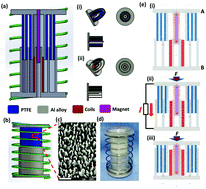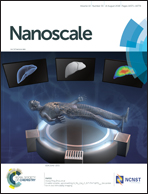A spring-assisted hybrid triboelectric–electromagnetic nanogenerator for harvesting low-frequency vibration energy and creating a self-powered security system†
Abstract
With the rapid development of portable electronics, exploring sustainable power sources is becoming more and more urgent. Utilizing a nanogenerator to harvest ambient mechanical energy could be an effective approach to solve this challenge. In this work, a novel spring-assisted hybrid nanogenerator (HG) consisting of a triboelectric nanogenerator (TENG) and an electromagnetic generator (EMG) was developed for harvesting low-frequency vibration energy. The results show that the TENG with a PTFE surface nanostructure has better output performance than that without the nanostructure. The effect of operating frequency on the open-circuit voltage and short-circuit current of the TENG and EMG is systematically investigated. Under a 2 Hz operating frequency, the EMG and TENG are able to produce a peak power of about 57.6 mW with a resistive load of 2000 Ω and 1682 μW with a resistive load of 50 MΩ, respectively. The impedance matching between the TENG and EMG can be realized by using a transformer to reduce the impedance of the TENG. The charging performance of the HG is much better than that of the individual EMG or TENG. The HG enabled us to develop a self-powered safety system and to power LEDs, and drive some electronic devices. The present work provides a superior solution to improve the output performance of the HG for harvesting low-frequency vibration energy.



 Please wait while we load your content...
Please wait while we load your content...